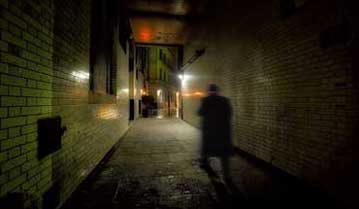THE GHOST OF COVENT GARDEN STATION
AND THE ADELPHI THEATRE
The tale of the ghost of William Terriss, which has been seen at various locations around Covent Garden, in London, has it all. It's a cracking ghost story, with a shocking murder at its heart. There's history, mystery and a touch of romance.
And, if all that is insufficient to send you out in search of Covent Garden's troublesome spectre, there's also a cameo appearance by Alfred Hitchcock.
What more could you ask for?
SOMETHING NEW IN GHOST STORIES
On Sunday the 15th of January, 1956, a chilling headline appeared in The Sunday Dispatch. It read:-
Something New In Ghost Stories
THE HAUNTED TUBE STATION SCARES PORTER AWAY
The accompanying article began by posing the tantalising question:-
Who is the ghost of Covent Garden Underground Station?
It then went on to inform readers that:-
"A four-page report has been sent to the London Transport Executive divisional headquarters. And this question has been put to officials:-
"Is the statuesque figure wearing white gloves, and seen by members of the station staff, the spectre of William Terriss, the actor stabbed to death at the Adelphi Theatre by a maniac 59 years ago?"
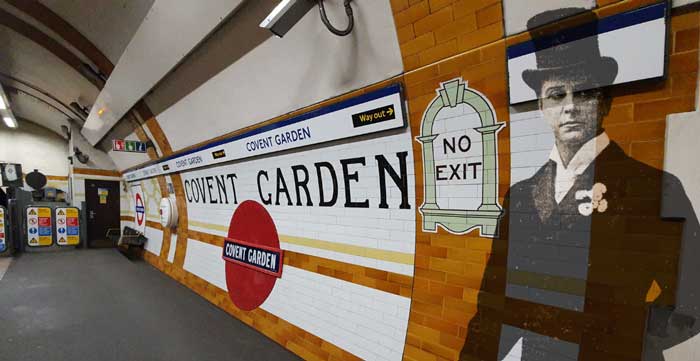
COVENT GARDEN UNDERGROUND STATION
The station in question stands at the junction of James Street and Long Acre in the bustling Covent Garden district of London.
Prior to the station being built the site was occupied by 19 James Street, which, since 1897, had been the premises of fruit growers and market gardeners Wyld and Robins.
In 1903, the building was acquired under a compulsory purchase order by The Great Northern, Piccadilly and Brompton Railway Company.
However, Wyld and Robins refused to give up their premises without a fight, and they took the railway company to court where they were awarded the princely sum of £5435 for loss of earnings.
THE STATION IS BUILT
With the matter of compensation settled, work on the new station could get underway, and the company's resident architect Leslie Green (1875 - 1908) set about designing it.
Green had been designing underground railway stations since 1903, and, by the time he sat down to draw up his blueprint for the new premises, he had developed his own unique and readily recognizable style, of which Covent Garden is a typical example.
The exterior is clad in distinctive ox-blood red glazed terracotta blocks. These were intended to create a strong, bold identity, which made them easy for customers to spot.
There are large and, again, noticeable, semi-circular windows on the first floor level, and the roof is flat in order to encourage commercial office building above, as has happened at Covent Garden Station.
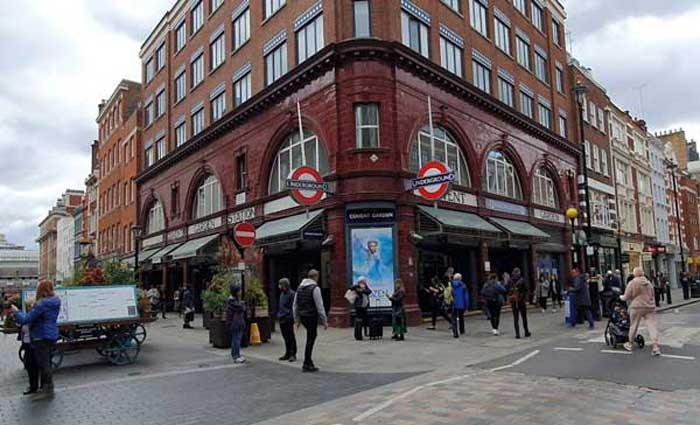
THE STATION OPENS - 1907
The station opened on Thursday the 11th of April 1907, and, since escalators wouldn't be introduced until 1911, passengers descended to or ascended from the depths either by way of a lift, or, if they were feeling particularly energetic, they could struggle up or down the 193 steps that linked the ticket hall with the platforms.
A helpful sign now warns those intending to attempt the ascent that the stairwell is equal to a 15 storey building, and that those with luggage, push chairs and heart conditions are advised in no uncertain terms to PLEASE USE THE LIFT!
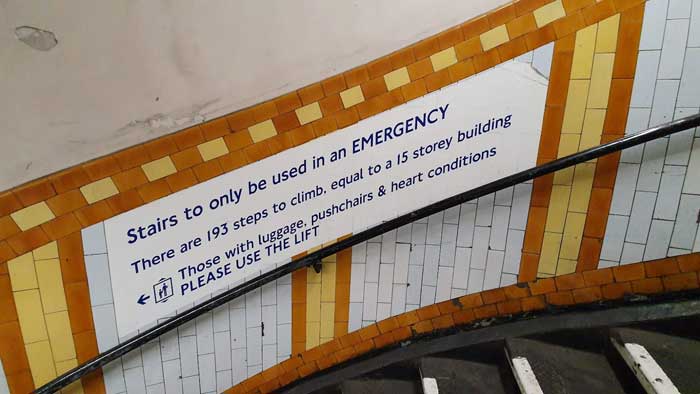
THE STATION PLATFORMS
The platforms are also typical of Leslie Green's unique style, the walls being lined with tiles of various hues and plenty room for the station name to be displayed prominently. Interestingly, each of Green's stations had its own distinctive pattern of tiling, reputedly to assist those who couldn't read to be able to tell which station they had actually arrived at.
However, the tiles that greet passengers today date from a major, though sympathetic, renovation in 2010, when the timeworn originals were replaced, albeit they maintained the style of their predecessors.
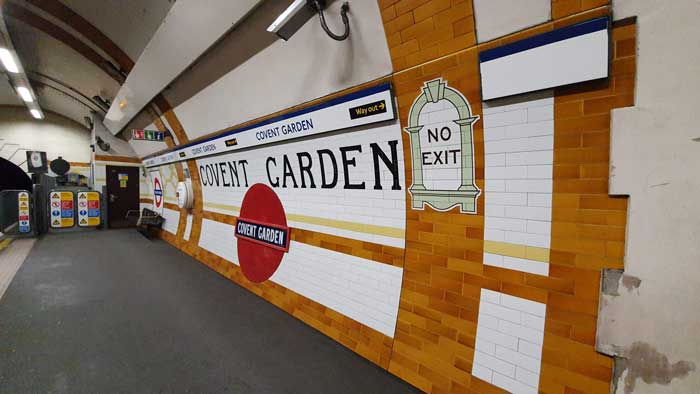
THE STATION ALMOST CLOSED
It has to be said that Covent Garden station didn't exactly set the commuting world on fire.
Indeed, so low were passenger numbers that, in 1929, it was earmarked for closure, as those who ran the network looked at improving efficiency by eliminating the less busy stations in the central area.
But Covent Garden was reprieved, and, in 2011, its future was secured when English Heritage gave it grade II listed status on the grounds of its being a good example of Leslie Green's architecture.
A GREAT PLACE TO HAUNT
But, enough of the station, what about the ghost?
Now, let me begin by saying that, if I were to find myself as a supernatural entity condemned to lurk around the darker recesses of a London Underground Station, then - well, let's just say that there are worse ones than Covent Garden to be condemned to haunt.
I could spend an eternity admiring the platform tiling - I don't get out much - and, so long as I didn't attempt the formidable plod up the stairs, I should imagine it would be a comfortable enough venue at which to enjoy an ethereal existence.
So it certainly justifies a four star rating in the Where To Haunt Guide, if, perchance, such a publication should happen to exist in the great beyond.
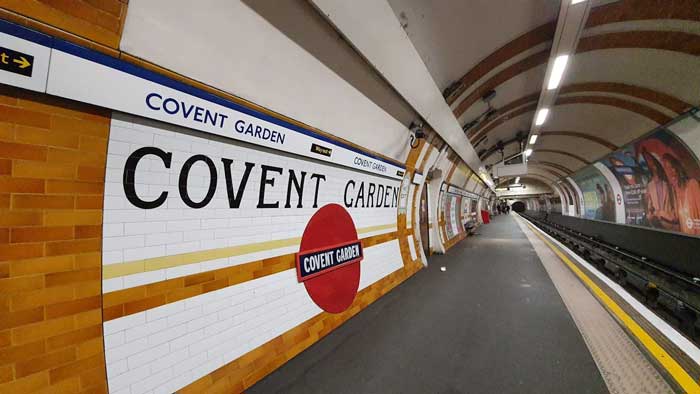
WHOSE IS THE GHOST?
But, to return to the question posed by The Sunday Dispatch on Sunday the 15th of January, 1956:- "Who is the ghost of Covent Garden Underground Station?" - although, call me pedantic, but I can't help wondering if that shouldn't be Whose is the ghost of Covent Garden Underground Station?
THE HAUNTING OF THE STATION BEGINS
For its first fifty or so years the station enjoyed an existence that was untroubled by paranormal activity.
But then, one night, just after midnight, in November, 1955 - with the last passenger having left the platform - Foreman Collector Jack Hayden was performing his final checks before the station's closure, when he saw a tall, distinguished looking man, go into the exit.
Thinking they might have a lingering fare-dodger on their hands, Hayden picked up the platform phone and, instructed the booking clerk, Bill, to "catch that man coming up the emergency stairs."
Bill wandered over to the top of the stairs and awaited the arrival of the panting ne'er do well.
"But," so The Sunday Dispatch informed its readers, "there was no one there."
THE MAN IN THE GREY SUIT
On November the 24th, at 12.40 p.m., Jack Hayden was sitting in the staff mess room with the door open.
"I saw a tall man wearing a grey suit, funny old collar and white gloves, looking at me from the ante-room," he told a Sunday Dispatch reporter. "I said, "Looking for the cloakroom, sir?" The thing disappeared. No one in the passage, not a sound of footsteps."
A MAN WAS STANDING THERE
At about midday, on the 28th of November, Hayden was sitting in the staff mess room with Station Woman Rose Ring, when their tea break was interrupted by a loud scream.
Moments later, Station Man Victor Locker came stumbling into the room in an extremely agitated state. "A man, he was standing there," he stammered to his colleagues, "it pressed down on my head, it vanished."
ERIC DAVEY TO THE RESCUE
If there's something strange in the station depths - who ya gonna call?
Well, on this occasion, Jack Hayden picked up the phone and rang headquarters at Leicester Square. "We have a ghost here," he informed whoever it was that answered his call.
And thus it was that Foreman Eric Davey, who also happened to be a spiritualist, was dispatched to Covent Garden Underground Station to try to solve the mystery of whose ghost was causing such consternation to the staff there.
Davey held a seance in the ante-room, and a reluctant Victor Locker was persuaded to attend, as the fearless foreman tried to make contact with the troublesome spectre.
Suddenly, Victor Locker cried out, "Mr Davey, Mr Davey, it's on you."
Unperturbed, Davey ploughed on with the séance. "I got the name Ter... something, and a murder nearby," he told the Sunday Dispatch reporter.
Davey also jotted down a quick psychic sketch of the spirit.
THE GHOST IDENTIFIED AS WILLIAM TERRISS
"That evening," the article continued, "somebody suggested Terriss.
Pictures of William Terriss, the Victorian actor who had been murdered outside the stage door of the Adelphi Theatre in Maiden lane on the 16th of December, 1897, were sought out. Not only did they match Eric Davey's sketch, but, when they were shown to Hayden and Locker, both cried out in unison, "That's him."
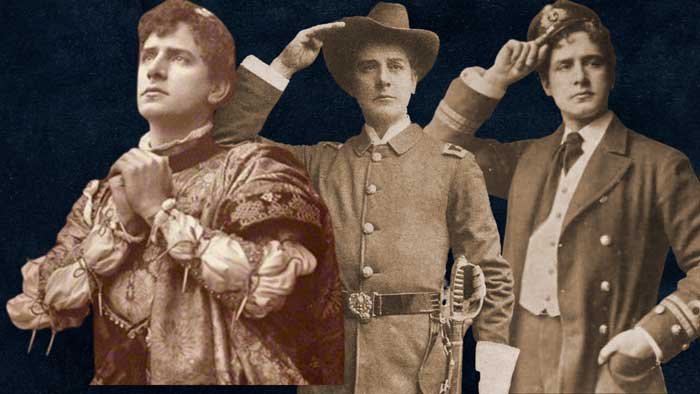
VICTOR LOCKER MOVES ON
Victor Locker, however, was not about to share his shifts with a supernatural squatter, no matter how great an actor he may have been in life, and, unable to bear working at the station any longer, he put in a transfer request which was granted immediately.
THE SPECTRE SEEN MORE THAN A DOZEN TIMES
According to Peter Underwood in his book Haunted London:-
"Over the next ten years the ghost was seen more than a dozen times, and, when Hayden left the station in 1965, he said the apparition invariably appeared during November and December and always looked exactly the same, and it usually appeared near a wall. He spoke to it several times, but it never answered.
The last time he saw it, late one November night in 1964, he was walking down the spiral stairway when he encountered the ghost walking up the same stairs. He hurried past the silent figure that did not seem to notice him and almost fell down the last few steps."
WILLIAM TERRISS'S GHOST RETURNS
Following Jack Hayden's departure in 1965, the ghost of Covent Garden Underground Station appears to have gone into hibernation for the next six years.
But then, in 1972, the apparition made several further appearances.
Andrew Green in his book Our Haunted Kingdom, published in 1973, stated that:-
"The ghost was seen late at night on the 24th and 27th of March 1972 by the station foreman and one of the female staff when in the main staff mess room. Mr Clifford, a porter, heard 'phantom' footsteps in the room, and Edward Pratt, an engineer, has often felt 'the presence of an unseen person' in the locality.
THE LIFT OPERATOR'S EXPERIENCE
That same year, a lift operator, having brought up the passengers from the last train, had locked up for the night, when, turning round, he saw what he later described as a "tall geezer dressed in old fashioned clothes - a waistcoat and tall hat" standing there.
Thinking he had inadvertently locked a passenger in, the operator apologised, and turned to get the keys to let the man out.
On turning back, the man was no longer there.
Puzzled by the passenger's disappearance, he descended into the station's depths, where he searched both platforms in case the man had gone down the stairs in the hope of catching a train, but he could find no sign of him.
When he informed his colleagues about his experience, one of them showed him a photograph of William Terriss. It was the spitting image of the figure that the operator had encountered.
PART OF THE JOB
According to Andrew Green:-
"Partly because he has been seen so frequently and the fact that his identity is known, the station staff now fully accept his visits as part of the job."
WHO WAS WILLIAM TERRISS?
But who was William Terriss, and why would his ghost haunt Covent Garden Underground Station?
William Charles James Lewin - to give the actor his actual name - was born on the 20th of February 1847.
After an education during which, according to a school friend, "if he gained but little learning, he at any rate acquired a perfect mastery in the art of tree-climbing", he attended Jesus College, Oxford, although he didn't actually take a degree.
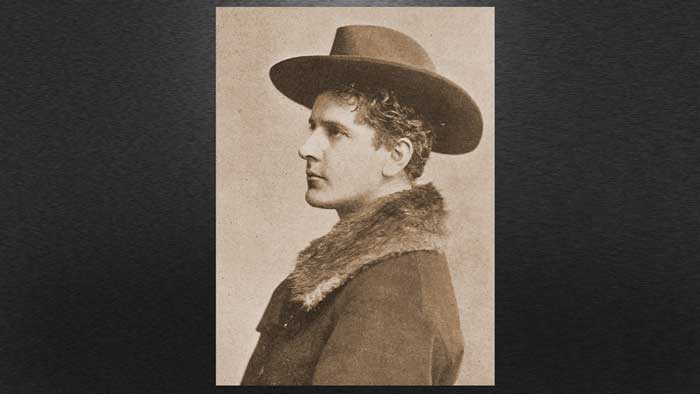
HE BECOMES AN ACTOR
Having tried his hand at several careers, which included a spate in the Merchant Navy and a period as a tea-planter in Bengal, he decided to become an actor and he adopted the stage name William Terriss.
With his handsome looks and commanding stage presence, he had soon established himself as a major theatrical force and soon audiences were flocking to see him. Indeed, according to The New York Dramatic Mirror, he was:- "one of the greatest and next to Henry Irving undoubtedly the most popular actor in England."
WILLIAM TERRISS AND JESSIE MILLWARD
In 1885, he met 24-year old actress Jessie Millward, and the two had soon become a popular pairing as romantic leads - and, according to some, it wasn't long before their romance soon spilled off the stage and into their personal lives.
In 1895, Terriss joined the Adelphi Theatre on London's Strand, and was soon enjoying even greater success as the hero in the melodramas for which the theatre was famed.
WILLIAM GILLETTE'S SECRET SERVICE
In July, 1897, it was announced that:- "Those popular artistes Mr. William Terriss and Miss Millward will make their reappearance at the Adelphi Theatre on August the 7th in Secret Service."
The play had been written by the American actor William Gillette, and Terriss played the part of Captain Thorne.
Following an initial run, the play closed at the Adelphi on Saturday the 4th of September, after which the company took the production on a tour of the provinces, although Terriss himself didn't take part in the tour.
THE MURDER OF WILLIAM TERRISS
Terriss reprised his role as Captain Thorne at The Adelphi Theatre on Wednesday the 24th of November, and, by mid December, he and Jessie Millward were playing to a full house every night.
On the morning of Thursday the 16th of December, readers would have opened their London newspaper to find the usual advert for that night's performance which would begin at 8 p.m.
At a little before 7.20 p.m., William Terriss, accompanied by his good friend Henry Graves, arrived by cab at the junction of Maiden Lane and Bedford Street.
They walked the short distance along Maiden lane to the stage door of the Adelphi Theatre, where William Terriss said, "Wait a minute, Harry, till I get my keys."
He reached into his pocket, took out his keys and then stooped slightly to put his key in the door.
As he did so, somebody rushed from the opposite side of Maiden Lane and struck him two rapid blows on the back. So quickly did this happen that Graves and several passers-by thought the action was nothing more than a friendly pat on the back.
Terriss appears to have thought likewise, and he turned round to face his attacker, whereupon the man plunged his knife into Terriss's chest.
"My God," gasped Terriss, "I am stabbed, arrest him."
At this point several of the theatre's scene-shifters rushed to the stricken actor's aid, and carried him into the passage, where they propped him up on pillows and piled ice onto his chest.
Two doctors from nearby Charing Cross Hospital soon arrived, but Terriss was beyond medical help, and, having been carried to the sofa in his dressing room, he died shortly before eight o'clock that evening.
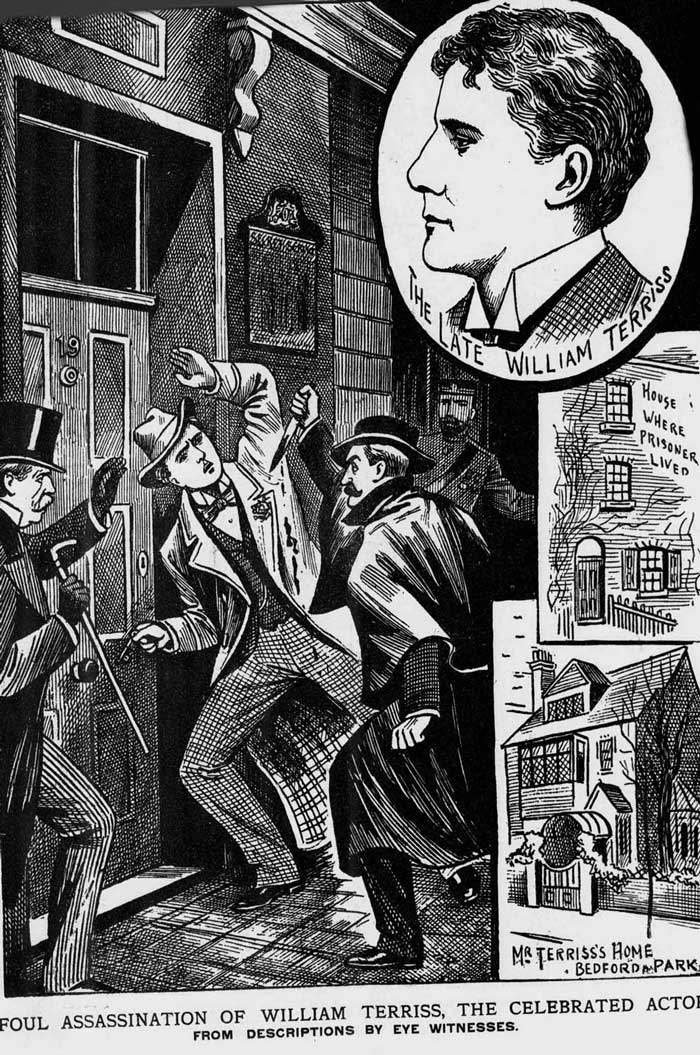
THE ARREST OF THE MURDERER
Henry Graves, meanwhile, had kept a close eye on the assassin, who seemed to be in no hurry to flee the scene.
When a police constable arrived, Graves pointed him out to the officer and said, "I charge this man with stabbing Mr. Terriss."
The constable and Henry Graves took the man, who was soon identified as Richard Archer Prince, to Bow Street Police Station.
"What made you do such a dreadful, bloody thing?", Graves asked Prince as they walked.
"In revenge," was his reply, "he blackmailed me for ten years. I have given him due warning plenty of times. I should either have to die in the street, or have my revenge."
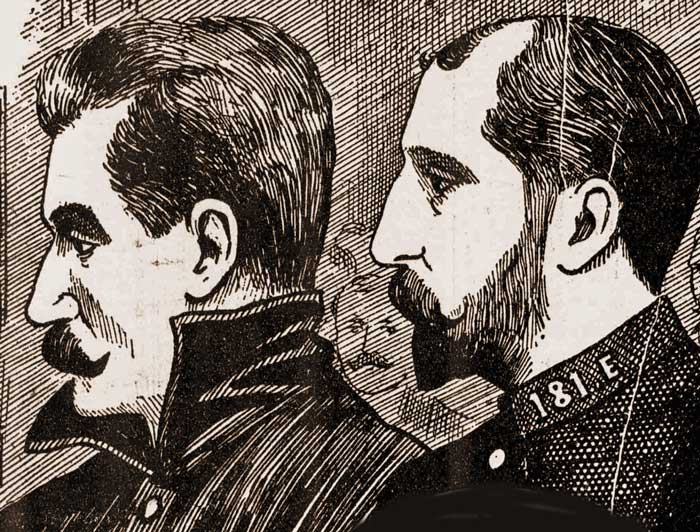
RICHARD ARCHER PRINCE
Richard Archer Prince was a minor actor who had actually performed with Terriss in several productions.
However, his career had stalled on account of his increasingly erratic behavior, plunging him into financial hardship.
Despite the fact that Terriss had tried to help him out both financially and by securing him roles, he had come to blame Terriss for his predicament.
His hatred festered, not helped by his excessive drinking, and on the evening of the 16th of December 1897, having purchased a knife, he had made his way to Maiden Lane, where he had stabbed Terriss as he arrived at the Adelphi Theatre.
STRANGE STORY MR. TERRISS'S DOG.
On Thursday the 23rd of December, under the above headline, The St James's Gazette published the following story, which was told to a reporter by William Terriss's son, Tom:-
"Mr. Tom Terriss relates a curious and inexplicable incident in connection with the assassination his father, the late William Terriss.
On the night the murder Mrs. Terriss was sitting in the drawing-room of The Cottage. Bedford Park, the late actor's home, with a pet dog - an intelligent fox-terrier called "Davie," after Mr. Terriss's favourite part of Lieutenant David Kingsley in "The Harbour Lights" - comfortably asleep upon her lap.
Messrs. William and Tom Terriss, the sons, were also in the room.
The clock marked twenty minutes past seven, when suddenly, without the slightest warning, the dog leaped from Mrs. Terrriss's lap and dashed frantically about the room, yelping, snapping, and showing all the signs of a paroxysm of mingled rage and fear.
"My mother was very much alarmed," Tom Terriss said, "and cried out, "What does he see? What does he see?", convinced that the dog's anger was directed at something unseen by us.
The incident occurred the very hour of my father's death."
THE FUNERAL OF WILLIAM TERRISS
William Terriss was laid to rest at Brompton Cemetery on Wednesday the 21st of December, and his funeral was, so The Daily Telegraph and Courier reported the next day, attended by a "vast concourse of sympathisers."
"Never, surely, have so many lovely flowers been brought to the last-resting place of an actor as those that made for ever memorable the last and saddest chapter in the brilliant career and honourable life of Mr. William Terriss," the newspaper informed readers.
QUEEN VICTORIA'S LETTER
Even Queen Victoria was moved to send a letter of regret to his bereaved family:-
"I send my condolences and deep sympathy to Mrs. William Terriss and her family in her bereavement. I deeply feel the loss which has robbed the English stage of one of its brightest ornaments."
THE SCENE AT THE GRAVE
The Leamington Spa Courier, on Saturday the 25th of December, described the scene at the graveside:-
"The deceased actor was buried side by side with his mother.
The mourners and immediate friends formed two abreast and passed the open grave to take their mute farewell.
The public, too, would not be denied, and thousands lingered around the grave long after those who were nearest and dearest to the dead actor had taken their departure.
Many who had never known Mr. Terriss off the stage were moved to tears, and the winter twilight had begun to gather before the last adieux were said."
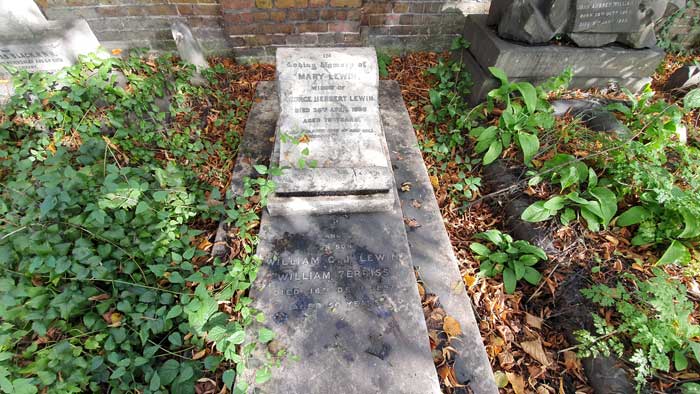
Brompton Cemetery
THE TRIAL OF RICHARD ARCHER PRINCE
As for Richard Archer Prince, his trial opened at the Old Bailey on Thursday the 13th of January 1898. Initially, he pled "guilty with the greatest provocation" to the murder of William Charles Lewin - Terriss's actual name.
However, the judge, Mr. Justice Channel, told him that no such plea was known to the law, and, on the advice of his counsel, Prince changed his plea to "not guilty."
The jury found him guilty of murder, adding that they believed him to have been insane when he committed the act.
He was sent to Broadmoor Criminal Lunatic Asylum. Where he remained until his death in 1937.
TERRISS'S FINAL WORDS
Peter Underwood, in his Guide To Ghosts And Haunted Places, published in 1996, revealed that Terriss's daughter, the singer and actress Ellaline Terriss, had told him that her father's last words as he lay dying were, "I will come back."
In his earlier book, Haunted London, published in 1974, Underwood told how, as Ellaline's husband, the actor Seymour Hicks, knelt by the body of his dead father-in-law, he heard a voice say to him, "Are there men living such fools as to think there is no hereafter?"; "and I knew beyond doubt,", Hicks would later state, "that I would meet William Terriss again."
HIS HAUNTINGS BEGIN
If, with his dying breath, William Terriss did, indeed, vow to come back, then he was most certainly true to his word.
In 1928, a visitor to London was strolling along Maiden Lane when he encountered a figure dressed in a grey suit of the type that had been fashionable at the turn of the century.
When the figure suddenly vanished, the man became convinced that he had seen a ghost.
Someone, the accounts don't specify who it was, showed him a photograph of William Terriss, and the man unhesitatingly confirmed that that was the man whose ghostly figure he had seen.
JUNE AND THE GHOST
On Thursday the 21st of March 1929, The Sheffield Independent published an article headlined "June's Wedding."
The subsequent article began:-
"There must have been more false rumours about June the dancer, who is tomorrow to be married to Lord Inverclyde, even than celebrities generally invoke."
The article concluded with the tantalising statement that:-
"...last year she had the pleasure or misfortune to be haunted in the Adelphi Theatre by the ghost of William Terriss."
JUNE TRIPP AND THE LODGER
June was, in fact, June Tripp (1901 - 1985), who had been a child ballet star and a protégée of Anna Pavlova, before also becoming an actress.
In 1926, she was recuperating in Antibes, after having had her appendix taken out, when she was approached by Welsh actor Ivor Novello (1893 - 1951), who asked her if she would play opposite him in, "an important film. No dancing required. You will act beautifully and we shall have fun," he enthused.
The film in question was The Lodger:- A Story of the London Fog, one of the earliest films to feature the story of the hunt for Jack the Ripper. It was released to universal acclaim in February 1927, and was the first successful film by a young up and coming director by the name of Alfred Hitchcock.
June Tripp played the part of Daisy Bunting, a model who becomes the lodger's love interest.
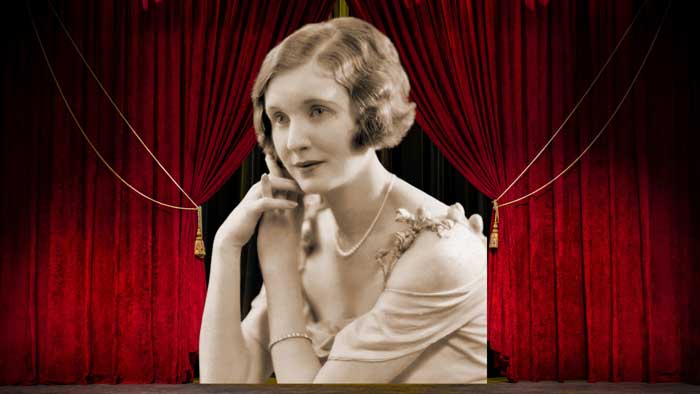
THE GHOST IN THE DRESSING ROOM
A year after the film's release, June Tripp was appearing in Clowns In Clover at the Adelphi Theatre, and, unbeknownst to her, she was given the dressing room in which William Terriss had died.
One day, she was resting between performances on a sofa in the dressing room when it began to shake as though someone was kicking it from underneath. She looked beneath it, but found nothing, and resumed her repose. But no sooner had she lay back down on the sofa than the shaking began again.
A green light then appeared above the mirror, and she heard two loud taps, whereupon the green light vanished and all became quiet.
HARRY PRICE HOLDS A SÉANCE
Her experience attracted the interest of renowned paranormal investigator Harry Price (1881 - 1948), the director of The National Laboratory of Psychical Research, and arrangements were made to hold a séance in June's dressing room in the hope of discovering the origins of the sofa shaking and mysterious raps.
On the night of Wednesday the 14th of March 1928, following that night's performance of Clowns In the Clover, a number of cast members, including June Tripp and Cicely Courtneidge (1893 - 1980), joined Harry Price and the well known medium Stella C. in the haunted dressing room, and, having formed a circle, they attempted to contact the spirit.
Sadly, as the Daily News reported in its next day's edition, "nothing happened," albeit the séance wasn't without incident, as, according to the Daily News reporter, who was also present:-
"The medium's alleged control, known as "Palma", rang a bell said to be out of her reach, played various musical instruments, and caused a table to charge me violently."
"June assured me that there were raps under the sofa on which she was sitting," the Daily News reporter concluded, "and once there was a noise as of something falling, which she said was like what happens in the room in the ordinary way, but it was agreed that we were no nearer a solution of the mystery."
WILLIAM TERRISS'S GRANDDAUGHTERS
In 1967, reporter David Gemmell enlisted the assistance of William Terriss's granddaughters Mrs Mildred Ohl, who had flown in from America, and Mrs Elizabeth Spillane to go hunting for their grandfather's ghost at the Adelphi Theatre.
"We drove up to Covent Garden on Sunday night," he reported in the Acton Gazette on Thursday the 26th of August 1967, "and parked the car.
We knocked on the stage door of the Adelphi Theatre, and were ushered in by the night watchman. He showed us to the Royal Box, and then, after switching on the small theatre sidelights, he left us to return to his bed and his book.
The search had begun.
Midnight came soon enough, and by this time the atmosphere of the empty theatre had stopped all conversation. We listened in silence to the silence."
PARANORMAL ACTIVITY
At one o'clock they made their way across the stalls and, as Mrs. Spillane pushed open a side door near the entrance to the stage, they heard a low sound like a moan.
Suddenly Miss Ohl cried out, "What's that?"
"We turned very quickly," Gemmell wrote in his article, "and saw a shadowy figure passing the small light at the back of the theatre. For a little more than a second we all saw it, and then it was gone. I ran to the back of the stalls and saw it again. This time it went through the doors into the lobby.'
The trio then went and sat in the front row of the stalls and waited, so Gemmell reported, "for the sounds we almost knew were coming.".
"The noise came from the dress circle. It moved from the left side to the right. A sound like deep breathing, or like a heavy coat brushing against the velvet backs of the circle seats."
They then returned to the Royal Box, where they found that their belongings had been moved about. They quizzed the night watchman, but he swore that he hadn't been anywhere near the Royal Box.
"This was not the perfect way to spend a Sunday night," Gemmell's report concluded, "but one thing must be admitted. The sequence of events after we saw the figure cannot be completely explained away naturally.
I do not know if the figure was William Terriss, nor if the noises were made by him. But I do know that both the granddaughters feel, without a shadow of doubt, that the events of the night were the work of their grandfather, William Terriss."
THE PLAQUE IN MAIDEN LANE
Today a green plaque on the wall of the Adelphi Theatre's Maiden Lane side remembers the tragedy that took, "outside this theatre" on the 16th of December 1897, when William Terriss, "Hero of the Adelphi Melodramas", met his untimely end.
There are, therefore, reasons aplenty for the ghost of William Terriss to haunt the site in Maiden Lane where his murder took place, and for his apparition frequenting the inside of the Adelphi Theatre.
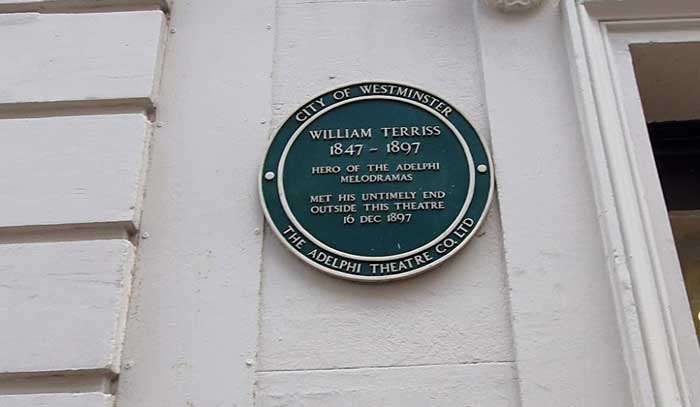
WHY SHOULD HE HAUNT THE STATION?
But why should he haunt Covent Garden Underground Station, which wasn't built until ten years after his untimely end?
To be perfectly honest, there is no feasible reason why Terriss should haunt the station, other than his possibly having become a posthumous fan of the work of Leslie Green!
Some accounts of the haunting explain his presence there by claiming that Terriss had a daily routine of stopping off at a bakery that used to stand on the site now occupied by the station, but there are no contemporary records of Terriss ever being in the habit of following such a routine.
In truth, there is no earthly explanation as to why William Terriss's ghost should haunt Covent Garden Station.
And yet staff who have encountered the spectre over the years have been adamant that it was that of William Terriss.
So, perhaps we should just accept that he haunts the station, and leave it at that.
For, to paraphrase the Bard:- "There are more things on the Piccadilly Line, Horatio, than are dreamt of in your philosophy."


